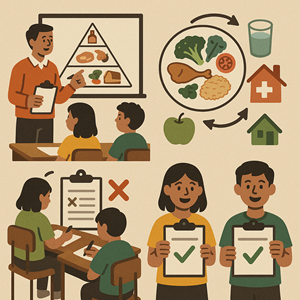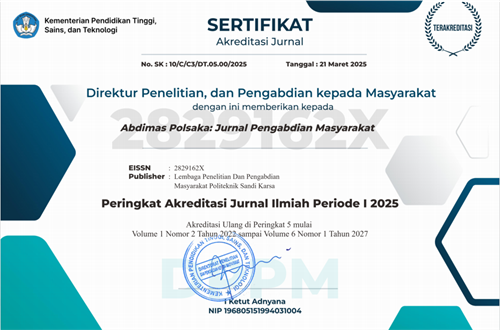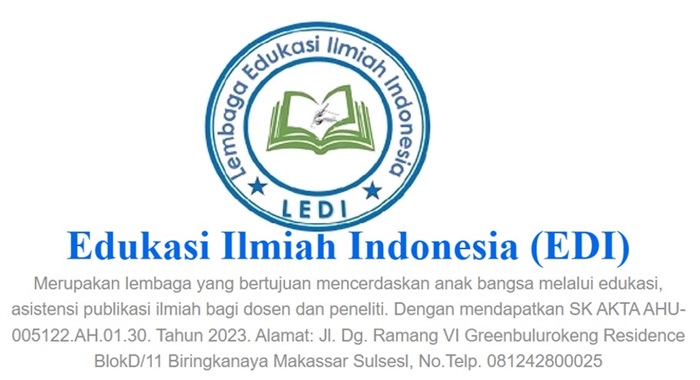Balanced nutrition education for adolescents: Pre-post test approach to increase awareness of healthy diets in disaster-prone areas
DOI:
https://doi.org/10.35816/abdimaspolsaka.v4i2.118Keywords:
Balanced Nutrition, Nutrition Education, Adolescents, Disaster-Prone AreasAbstract
Adolescents are vulnerable to nutritional problems, especially in disaster-prone areas where access to nutritious food is limited. Sigi District, Central Sulawesi, was severely affected by the 2018 earthquake and liquefaction, which disrupted food security and increased instant food consumption. This study aimed to evaluate the effectiveness of balanced nutrition education using a pre-test and post-test approach in improving students’ knowledge of healthy eating at SMK 1 Sigi. The intervention involved 30 students who received lectures and leaflets on the Balanced Nutrition Guidelines. Knowledge was assessed through pre- and post-tests, and differences were analyzed statistically. Results indicated a significant increase in mean knowledge scores from 37.31 ± 15.89 to 65.77 ± 21.20 (p < 0.05). The proportion of students in the poor category decreased from 93.33% to 30%, while those in the fair and reasonable categories increased substantially. These findings highlight that simple educational interventions can enhance adolescents’ nutritional awareness in disaster-affected areas. Therefore, balanced nutrition education should be integrated into school health programs as a sustainable preventive strategy
Downloads
References
M. Fuady, R. Munadi, and M. A. K. Fuady, “Disaster mitigation in Indonesia: between plans and reality,” IOP Conf. Ser. Mater. Sci. Eng., vol. 1087, no. 1, p. 012011, Feb. 2021,. DOI: https://doi.org/10.1088/1757-899X/1087/1/012011
A. Suppasri et al., “Cascading disasters triggered by tsunami hazards: A perspective for critical infrastructure resilience and disaster risk reduction,” Int. J. Disaster Risk Reduct., vol. 66, p. 102597, Dec. 2021, DOI: https://doi.org/10.1016/j.ijdrr.2021.102597
L. Hunter, S. Gerritsen, and V. Egli, “Changes in eating behaviours due to crises, disasters and pandemics: a scoping review,” Nutr. Food Sci., vol. 53, no. 2, pp. 358–390, Feb. 2023, DOI: https://doi.org/10.1108/NFS-12-2021-0385
N. P. Rosenheim, M. Watson, J. Casellas Connors, M. Safayet, and W. G. Peacock, “Food Access After Disasters,” J. Am. Plan. Assoc., vol. 90, no. 3, pp. 452–470, Jul. 2024, DOI: https://doi.org/10.1080/01944363.2023.2284160
N. U. Dewi et al., “Factors Associated with Diet Quality among Adolescents in a Post-Disaster Area: A Cross-Sectional Study in Indonesia,” Nutrients, vol. 15, no. 5, p. 1101, Feb. 2023, DOI: https://doi.org/10.3390/nu15051101
M. Musfira and V. Hadju, “Nutrition and dietary intake of adolescent girls in Indonesia: A systematic review,” Scr. Med. (Brno)., vol. 55, no. 4, pp. 473–487, 2024, DOI: https://doi.org/10.5937/scriptamed55-49461
V. Sember, G. Jurak, M. Kovač, S. A. Morrison, and G. Starc, “Children’s physical activity, academic performance, and cognitive functioning: a systematic review and meta-analysis,” Front. public Heal., vol. 8, p. 536635, 2020. DOI: https://doi.org/10.3389/fpubh.2020.00307
T. Y. Nour and K. H. Altıntaş, “Obesity after Natural disasters and Associated Risk Factors: A Systematic Review – ERRATUM,” Disaster Med. Public Health Prep., vol. 19, p. e15, Jan. 2025, DOI: https://doi.org/10.1017/dmp.2025.2
S. Noreen and Z. Iqbal, “Effectiveness of Social Practice Approach for Academic Achievement of Adult Learners in Basic Literacy: A Mixed‐Methods Study,” Eur. J. Educ., vol. 60, no. 1, p. e70015, Mar. 2025, DOI: https://doi.org/10.1111/ejed.70015
R. Sabriana, R. Riyandani, and R. Rosmiaty, “Pemberdayaan Ibu Hamil Melalui Peningkatan Pengetahuan tentang Pentingnya Gizi dalam Kehamilan untuk Mencegah terjadinya Anemia,” Abdimas Polsaka, vol. 1, no. 1, pp. 7–11, Mar. 2022, DOI: https://doi.org/10.35816/abdimaspolsaka.v1i1.4
S. Suprapto, “Pengaruh Edukasi Media Kartun Terhadap Peningkatan Pengetahuan Ibu dan Status Gizi Anak,” J. Heal., vol. 9, no. 2, pp. 81–87, Jul. 2022, DOI: https://doi.org/10.30590/joh.v9n2.500
A. S. Asmi, I. A. Tyarini, M. K. F. Saputra, J. A. Putra, and H. K. Son, “Video media is more effective to improve balanced nutrition knowledge,” J. Ilm. Kesehat. Sandi Husada, vol. 13, no. 2, pp. 242–249, Dec. 2024,DOI: https://doi.org/10.35816/jiskh.v13i2.1210
G. A. S. Rezende, M. T. Rezende, and C. M. Carneiro, “Low-Cost Interventions to Improve Cervical Cancer Screening: An Integrative Review.,” in Oncology Nursing Forum, 2023, vol. 50, no. 1, DOI: https://doi.org/10.1188/23.ONF.59-78
M. Shuremu, K. H. Abate, and T. Belachew, “Effect of nutrition education intervention to improve dietary diversity practice and nutritional status of the older people: A cluster randomized controlled trial,” Food Sci. Nutr., vol. 11, no. 11, pp. 7383–7395, 2023. DOI: https://doi.org/10.1002/fsn3.3667
S. Kaur, “Barriers to consumption of fruits and vegetables and strategies to overcome them in low-and middle-income countries: a narrative review,” Nutr. Res. Rev., vol. 36, no. 2, pp. 420–447, 2023, DOI: https://doi.org/10.1017/S0954422422000166
A. N. Daly, E. J. O’Sullivan, and J. M. Kearney, “Considerations for health and food choice in adolescents,” Proc. Nutr. Soc., vol. 81, no. 1, pp. 75–86, 2022, DOI: https://doi.org/10.1017/S0029665121003827
S. Suprapto, D. Arda, M. Kurni Menga, B. Adji Saktiawan, and S. Nggaá Woge, “OPTIMALCARE: Community-based homecare policy innovation in accelerating stunting reduction in Makassar City,” Abdimas Polsaka, vol. 4, no. 2, pp. 148–156, Aug. 2025, DOI: https://doi.org/10.35816/abdimaspolsaka.v4i2.107
Y. Chen, F. J. A. Perez-Cueto, A. Giboreau, I. Mavridis, and H. Hartwell, “The promotion of eating behaviour change through digital interventions,” Int. J. Environ. Res. Public Health, vol. 17, no. 20, p. 7488, 2020, DOI: https://doi.org/10.3390/ijerph17207488

Additional Files
Published
How to Cite
Issue
Section
License
Copyright (c) 2025 Febiani Riskika, Ummu Aiman, Aldiza Intan Randani, Nurulfuadi, Try Nur Ekawati Lukman, Linda Ayu Rizka Putri

This work is licensed under a Creative Commons Attribution 4.0 International License.




















